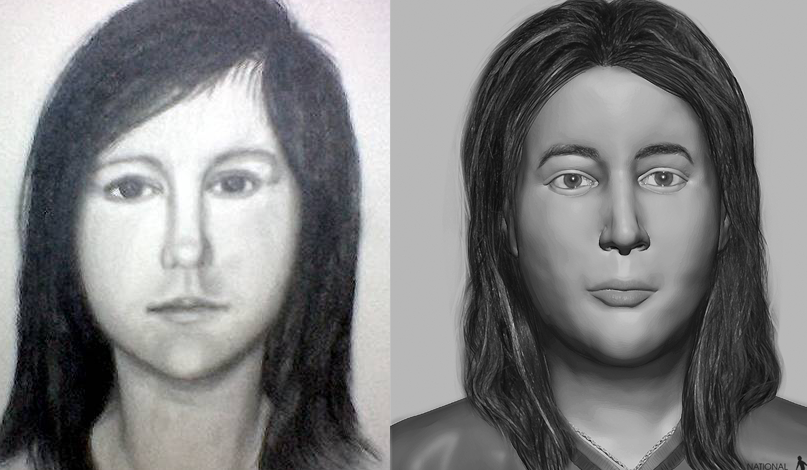

Left: A sketch created by a forensic artist using details provided by Donna Kinlaw. Right: The most recent, and most accurate according to detectives, digital composite created from a CT scan of Princess Doe’s skull (Photos: Warren County Prosecutor’s Office)
New tests performed on hair and tooth samples taken from the body of Princess Doe, the unidentified young woman found beaten to death in a New Jersey cemetery in 1982, suggest she spent time in the Long Island area prior to her death and was likely originally from Arizona.
Retired Det. Lt. Stephen Speirs appeared on CNN Saturday morning to give an update on the first round of tests investigators hope will lead to Princess Doe’s identity.
“We know that from 10 months to 7 months [prior to her death] she lived in a particular region of the United States which they refer to as Region 1, which covers a good portion of the northeast and some of the mid west,” said Speirs regarding the hair sample testing. “And then at approximately 7 months to 5 months what we discovered was that she was definitely transient. She went from one particular region of the United States to another which is Region 2. And for the last five months she was in Region 2 of the United States which puts her in the northeast area.”
Speirs said one of Princess Doe’s teeth was also sent out for isotope testing, which gave investigators an idea of where she spent her early life.
“We’ve determined that there’s a potential she could have come from the Midwest area meaning, quite honestly, Arizona is what we’re focusing on now,” said Speirs.
Speirs said investigators have also received phone calls regarding Princess Doe’s clothes.
“We’ve gotten phone calls from three separate individuals in the Long Island area,” said Speirs. “When they saw the pictures of the composite, as well as the picture of the clothing, three separate people told us they bought the exact same dress from a dress store in the Long Island area. And we have been focusing our efforts in the Long Island area as well.”
These are just the first round of recently submitted test results that have come back in a new push to give Princess Doe back her name.
In 1999, Princess Doe’s body was exhumed to retrieve DNA from her remains, but forensic science has evolved since then and 30 years later investigators hope that resubmitted DNA will yield more answers.
“Preliminary results from those tests suggest that we may have some trace evidence that does not belong or was not contributed by Princess Doe,” Speirs told the Press in August. “Now, we can resubmit [the DNA] because we can do so many better things now. It’s more advanced so we can take the smallest amounts of trace evidence and be able to develop a DNA profile.”
That means detectives could actually have DNA belonging to Princess Doe’s killer right now, or at the very least, the DNA of someone close to her before she died who might be able to identify her.
“If this evidence does prove to be contributed not from Princess Doe, but from someone other than Princess Doe, then that clearly gives us a person of interest,” said Speirs. “I’ve never been more optimistic than I am now, and I’ve been around the block on everything you can imagine, all over the place, with this case.”
Detectives also released a brand new composite of Princess Doe this past July, using the latest technology from the Smithsonian Institute in Washington, D.C.
The new composite, which police say is the most accurate to date, may give some credibility to the story of one woman who claimed she was in the cemetery when Princess Doe was killed.
A hand-drawn sketch previously created by a forensic artist with the help of Donna Kinlaw, who told police she witnessed Princess Doe’s murder at the hand’s of currently incarcerated convicted murderer Arthur Kinlaw, her husband at the time, bears similarities to the new computer-generated image. Donna also told detectives the woman was from the Long Island area.
While detectives say Arthur had once claimed responsibility for the crime, neither of the Kinlaws’ stories of what allegedly happened to Princess Doe could ever be confirmed.
If you have any information on Princess Doe, please call the anonymous tip line at 1-866-942-6467.





